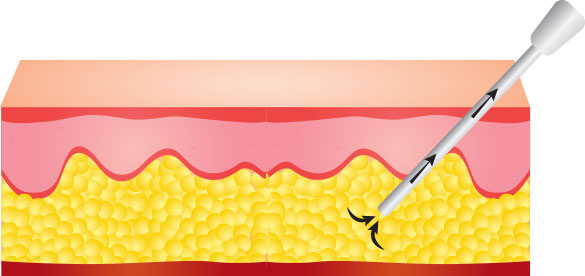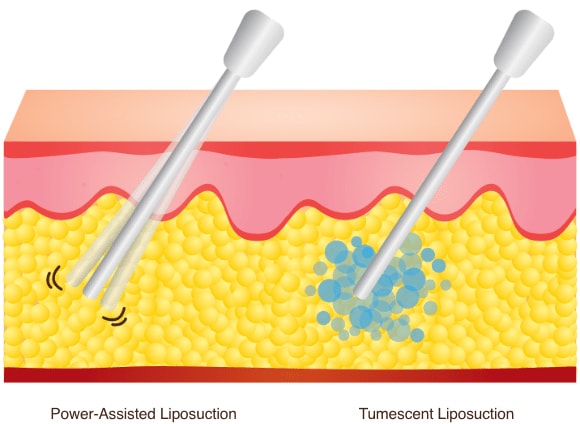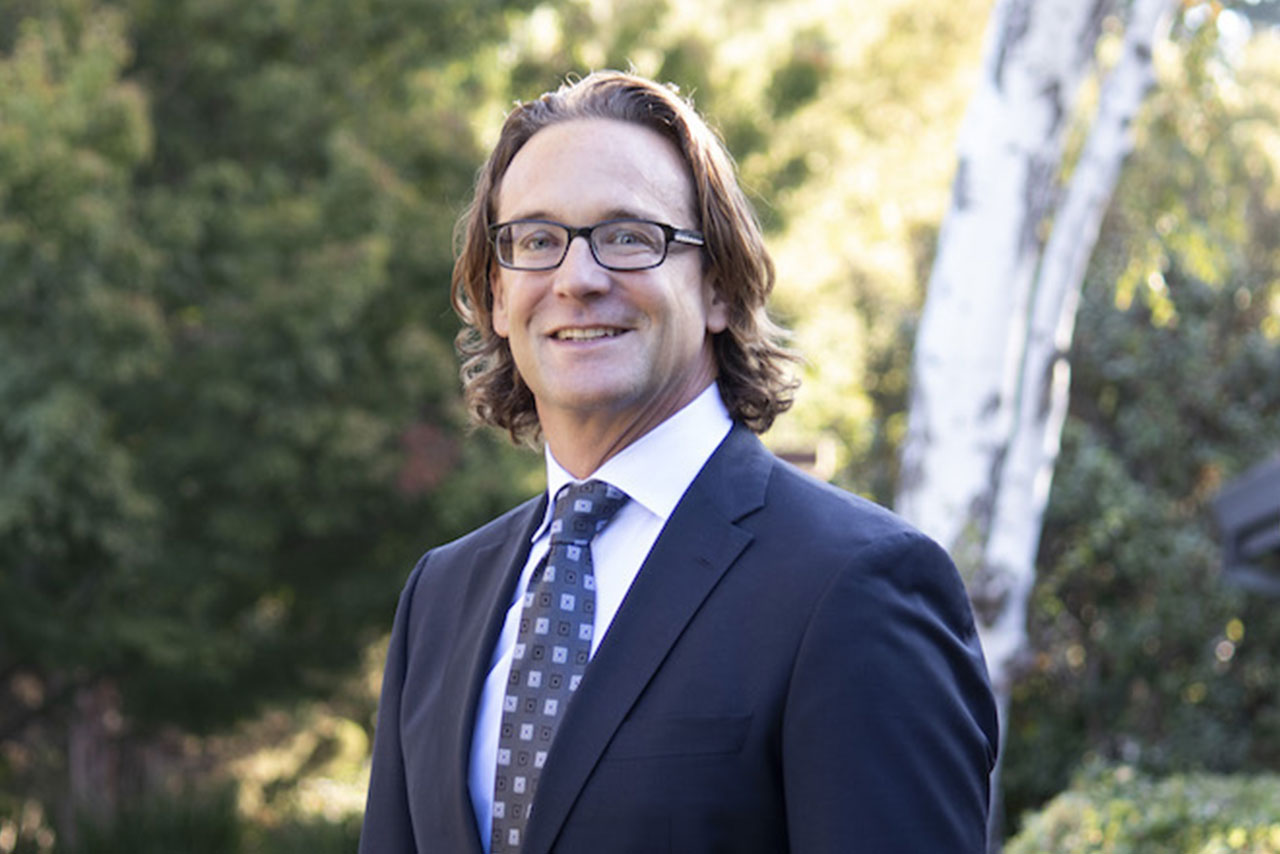Liposuction is celebrated for its ability to sculpt the body and make patients look and feel glamorous, youthful, and rejuvenated. At our practice, Dr. Charles Perry performs liposuction to remove stubborn, unwanted fat deposits from targeted areas of the body. Liposuction is effective on its own as a body contouring procedure, though it can also be combined with other techniques to refine contours.
Liposuction is a cosmetic procedure designed to remove excess fatty tissue from targeted locations on the face and body. The technique can be used to slim the face, chin, neck, upper arms, trunk, abdomen, buttocks, hips, thighs, knees, calves, and ankles. Liposuction is not a replacement for weight loss and is best used to address localized fat deposits that have not responded to diet or exercise.

Virtually any area of the body can be sculpted, contoured, and enhanced with liposuction. Some of the most common locations to target are:
You may also wish to address multiple areas, and Dr. Perry will provide a customized treatment plan based on your needs and goals. Liposuction targets specific areas, but a smooth and even body shape offers a more flattering outcome, and Dr. Perry uses advanced techniques to provide improvement that benefits the entire silhouette.
The results of liposuction in areas such as the abdomen and inner thighs can be enhanced even further with the addition of a CoolTone® procedure. CoolTone® is a non-surgical treatment designed to improve muscle tone in specific body areas, offering patients a way to achieve stronger tone and clearer definition. This treatment can be an effective “add-on” to liposuction in the inner thighs and/or abdomen for many individuals.
All forms of liposuction are designed to remove unwanted fat cells. However, several different types of this technique are available, and the right one for you will depend on the location addressed, the types of fatty tissue you have in the area, and other factors unique to you.
At our practice, we use power-assisted liposuction, in which a vibrating cannula breaks apart the targeted fat cells in order to remove them. We sometimes incorporate tumescent liposuction, as well. This innovative technique involves a “wetting” saline solution made up of anesthetic and other medicines. The solution is designed to help break up fatty tissue, reduce discomfort, and minimize risk of infection.

If you are of normal weight, eat a healthy diet, exercise, and are willing to continue this healthy lifestyle after undergoing liposuction, you are likely an excellent candidate for this procedure. When healthy lifestyle practices are maintained over a lifetime, liposuction patients will preserve their improved body contour and may even see the contour improve.
Liposuction is not recommended for:
Poor skin quality may be due to weight loss, stretch marks, or aging and will result in subpar results. For these individuals, the skin will not conform to your new contours and additional surgical techniques may be required to tighten excess skin.
**Disclaimer: If you are a smoker, you MUST DISCONTINUE smoking a minimum of 4 weeks BEFORE & AFTER SURGERY. A nicotine test will be administered.*
With the advent of new, non-surgical body contouring techniques such as CoolSculpting®, many individuals wonder whether it’s possible to avoid surgical procedures like liposuction to achieve their goals. Both liposuction and CoolSculpting® offer numerous advantages for ideal candidates; however, there are several distinctions between them, ultimately making one a better option than the other depending on an individual’s aesthetic concerns.
The most prominent difference among these options is that liposuction requires surgery while CoolSculpting® does not. With liposuction surgery, patients can expect residual scarring (although the incisions are typically quite small and can often be placed in relatively discreet areas), as well as a recovery period. Also, liposuction is usually performed while the patient is under general anesthesia. With that in mind, liposuction is capable of reducing large volumes of fat and producing immediate results after just a single treatment.
CoolSculpting® is also able to remove excess fat in specific body areas, but works in a much different way. This technique does not require surgical incisions or general anesthesia. CoolSculpting® uses applicators placed on the skin of the treatment area to initiate a controlled cooling effect on excess fat cells. The treatment is designed to break the fat down and allow the body to progressively expel the fat through its natural filtration processes. Most individuals do not need a recovery period after CoolSculpting®. With all of the benefits offered by CoolSculpting®, it’s important to know that this treatment is not right for everyone. Unlike liposuction, CoolSculpting® can only address mild to moderate levels of excess fat, and the results are not instant. In fact, they should appear gradually over the following months. Additionally, CoolSculpting® frequently requires a series of treatments spread out over time to produce optimal results. While this option can be ideal for many patients, others may have concerns and goals that would be much better served with liposuction rather than CoolSculpting®.
During your consultation, Dr. Perry can talk more with you about the advantages and disadvantages of liposuction and CoolSculpting®. Once he has had the opportunity to examine you and discuss your expectations, Dr. Perry can make a recommendation as to which option is the more ideal choice.
Many patients have aesthetic concerns relating to the abdominal region of the body. These concerns range from excess fat collection to loose muscles and lax skin, both of which can affect abdominal contours and create a protruding or “overhanging” appearance. Both liposuction and tummy tuck surgery (also known as abdominoplasty) offer patients a way to enhance abdominal contours, but these procedures are designed to address separate conditions. Liposuction can remove excess fat in the abdominal area; however, it will not have any effect on excess, inelastic skin or loose musculature in the abdomen. Tummy tuck surgery is designed to tighten these muscles (and repair them, if necessary) and remove lax skin. Once this is accomplished, the remaining skin is pulled taut and shaped to provide a firmer, flatter look.
Some patients’ abdominal appearance may be primarily affected by excess fat; therefore, a liposuction procedure may be effective as a standalone treatment. For those who are affected by excess skin and loose abdominal muscles, a tummy tuck procedure may be recommended. In cases where the concerns are being caused by excess fat as well as excess skin and lax abdominal muscles, liposuction and tummy tuck surgery as a combined procedure can address these issues. Once Dr. Perry has examined you and determined exactly what is causing your aesthetic concerns, he can advise you on the treatment plan that is most capable of meeting your expectations and successfully achieving your goals.
In addition to tummy tuck surgery, liposuction can accompany a variety of different cosmetic procedures to produce more optimal results. For example, liposuction techniques are frequently incorporated into arm lift and thigh lift surgeries, and liposuction is used in Brazilian butt lift procedures as part of the fat grafting process. Additionally, because pregnancy and childbirth can often result in buildups of isolated fat, liposuction is a popular choice for patients to include in a Mommy Makeover. Certain facial enhancement surgeries (i.e. with facial fat transfer) may also involve liposuction based on your individual needs and goals.
At our practice, several liposuction techniques are available. However, Dr. Perry prefers the tumescent liposuction technique. In this method, the targeted areas of fatty tissue are injected with a tumescing fluid, which contains epinephrine (adrenaline) and diluted local anesthetic. This fluid causes the fat cells to “tumesce,” making them swell and become firm, thus simplifying the removal of stubborn deposits. When compared to other liposuction techniques, tumescent liposuction is associated with less discomfort during the procedure, as well as an easier recovery period characterized by less bruising and pain.
Liposuction is performed as an outpatient surgery, which means you should be able to return home the same day. The treated area will be wrapped in bandages, and drains may be used to enhance your healing process. Medication will be prescribed to minimize your pain, and you should expect some minor discomfort, as well as bruising and swelling, for the first several days. Bruising and swelling will continue after this point, though much decreased, and should subside with time. Most patients take about a week off from work to recover, though some may need additional time depending on their treatment plan. While many activities will be fine to engage in after about two weeks, rigorous exercise should be avoided for at least a month. Dr. Perry will provide additional details at your initial consultation.
The incisions made are small, therefore the scars are also typically small and unnoticeable. The location and number of the incisions will depend on which areas you have treated and your individual treatment plan. Dr. Perry will go over the details at your initial consultation. If you are prone to hypertrophic or keloid scars, you should mention this during the meeting. If you would like to enhance the healing process regarding the scar’s appearance, we offer a range of laser skin resurfacing options that can assist in minimizing surgical marks.
The price of liposuction will depend on the complexity of your treatment plan, the number of areas you wish to address, the amount of tissue you have removed, and other factors unique to you. As of 2024, the all-inclusive general price ranges for liposuction at our practice as they pertain to specific body areas are as follows:
Again, the exact price estimate will depend on unique factors associated with your customized liposuction treatment plan. We want you to have the most accurate and up-to-date information to make the right decision for you, so we will provide the total anticipated cost of your procedure at your consultation. If you would like to consider plastic surgery financing, we work with a number of highly reputable lending agencies that offer appealing rates to qualified applicants. We also accept a number of traditional payment options.
Nothing can remove fatty tissue in targeted areas in the exact same way or to the degree liposuction can; however, there are a number of innovative non-surgical treatments available that can help contour the body and reduce pockets of fat with good results. We offer CoolSculpting® for body contouring and KYBELLA® for chin refinement, both of which have minimal downtime and typically desirable outcomes. We are happy to discuss these options and any other alternatives with you at your initial appointment. We want you to have access to the ideal treatment for your needs, goals, and preferences.
Liposuction is one of the most popular cosmetic procedures available, and it can provide dramatic results for the right patient. To help you determine if liposuction is right for you, Dr. Perry has answered some commonly asked questions as a helpful resource. For more information, please contact our practice and schedule a consultation to learn more.
Just like any surgical procedure, liposuction carries certain risks. While these risks are rare, those considering liposuction should educate themselves before making their decision to undergo this procedure. Below is an introduction to the risks of liposuction; for more information, schedule your consultation to speak with Dr. Perry.
Change in skin sensation
It’s possible to experience a temporary loss of skin sensation after liposuction, but sensation will return over time. In rare cases, diminished or complete loss of sensation does not completely resolve.
Skin discoloration/swelling
Commonly, skin discoloration and swelling are experienced after liposuction. It’s rare for swelling and discoloration to persist for a long time, and permanent skin discoloration is also unusual.
Unsatisfactory result
Despite realistic expectations about the results of liposuction, some patients are disappointed with the outcome. In rare cases, a patient’s results are improved through additional surgery.
Irregular skin contour
Irregularities such as dimpling, wrinkling, and skin depressions may follow liposuction, possibly requiring additional treatments, including surgery, to correct.
Asymmetry
Normal pre-surgery asymmetry in the body’s features is affected by skin, muscle tone, and bone prominence. Just as the body is not symmetrical before liposuction, it will not be symmetrical afterward.
Infection
Like tummy tuck or any other surgery that we offer at our practice, infection after liposuction surgery is unusual. However, the rare development of an infection would require treatment using antibiotics or additional surgery.
Bleeding and seroma (fluid accumulation)
It’s unusual, but possible, to have a bleeding episode during or after liposuction. If significant postoperative bleeding occurs, you may require emergency treatment to drain the blood. In addition, it is possible for fluid accumulation to occur in areas sculpted with liposuction. The draining of this fluid, as well as additional surgery, may be necessary.
Surgical shock
Especially when multiple or extensive areas are treated with liposuction, the procedure can cause severe trauma, including infections or excessive fluid loss that can cause severe illness or even death. For this reason, patients planning large volume liposuction (greater than 5000 cc’s) may be advised to be monitored post-operatively and remain overnight in the hospital.
Skin loss or chronic pain
Skin loss and chronic pain after liposuction are extremely rare conditions but can occur.
Pulmonary complications
In very rare cases, fat embolism syndrome — when the lungs trap fat droplets — can occur and is sometimes deadly. This complication necessitates hospitalization and additional treatment.
Need for additional surgery
Complications from liposuction are rare but cannot be predicted. In some cases, complications will create a need for additional surgery or other treatments.
While liposuction can remove significant amounts of fat, please note that it should not be considered an alternative to weight loss strategies (e.g. exercise, diet, bariatric surgery, and so on). Rather, liposuction is for patients at a relatively healthy weight who want to remove stubborn fat buildup in specific areas.
Moreover, when conducted properly by a qualified professional, liposuction can remove up to 70% of fat in a given area. For safety purposes, larger amounts of fat are often performed in a series of procedures rather than one single surgery.
Cellulite refers to dimpled fat deposits that can sometimes show up in areas prone to large fat buildup. Unfortunately, liposuction alone is not designed to remove cellulite, and can even make the dimpling more pronounced (though in rare cases, it has successfully removed very marginal amounts of cellulite).
Dr. Perry routinely answers patient questions through the online plastic surgery resource known as RealSelf. To see the responses he’s given about liposuction, please follow the link below.
If diet and exercise have left you disappointed, consider liposuction as a way to attain the beautiful body you deserve! Our practice offers state-of-the-art liposuction techniques, as well as a surgeon skilled in safely giving you the body contour you desire. Contact our practice today to learn more about liposuction, or to schedule a consultation.
